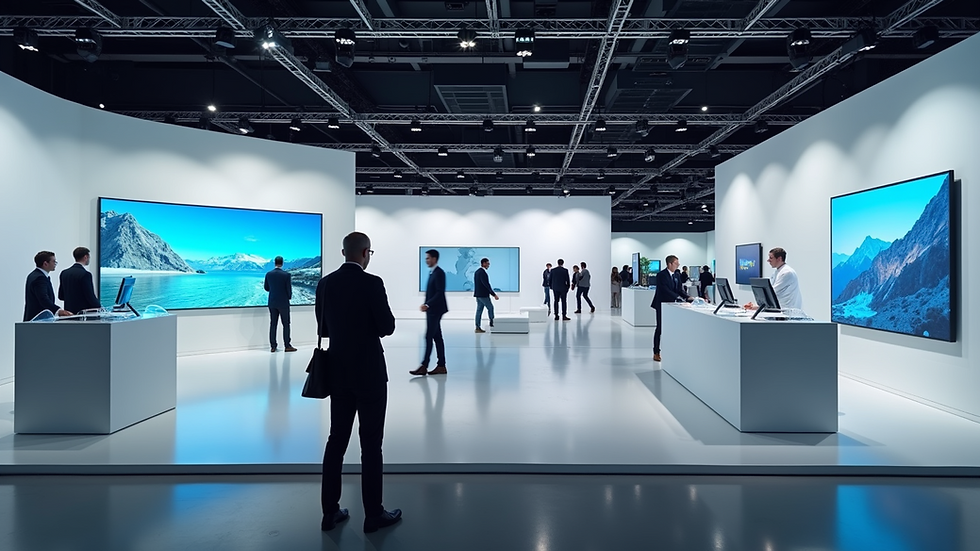Maximizing B2B Events for Measurable Growth
- pexuus media
- 5 days ago
- 3 min read
Business-to-business (B2B) events offer a unique opportunity to build relationships, showcase products, and generate leads. Yet many companies struggle to turn event participation into clear, measurable growth. The challenge lies in moving beyond simply attending or exhibiting to creating a strategic approach that delivers tangible results.
This post explores practical ways to maximize B2B events for measurable growth. It covers planning, execution, follow-up, and measurement, with real-world examples to guide your efforts.
Setting Clear Goals Before the Event
Success starts with defining what growth means for your business. Without clear goals, it’s impossible to measure impact or adjust strategies.
Identify specific objectives such as generating qualified leads, closing sales, building brand awareness, or launching a new product.
Set measurable targets like the number of leads, meetings scheduled, or demos given.
Align goals with overall business priorities to ensure event efforts support broader growth plans.
For example, a software company might aim to schedule 30 product demos during a trade show, while a consulting firm may focus on securing 10 new client meetings.
Choosing the Right Events to Attend
Not all events deliver the same value. Selecting the right ones requires understanding your target audience and where they gather.
Research industry conferences, trade shows, and networking events relevant to your niche.
Evaluate attendee profiles, event size, and past success stories.
Consider the event format: in-person, virtual, or hybrid, and how it fits your engagement style.
A manufacturing supplier targeting automotive companies might prioritize a specialized automotive parts expo over a general industrial trade show.
Designing an Engaging Booth or Presentation
Your presence at the event must capture attention and communicate value quickly.
Use clear, concise messaging focused on how your product or service solves customer problems.
Incorporate interactive elements such as demos, samples, or live presentations.
Train your team to engage visitors with open-ended questions and listen actively.
For instance, a cybersecurity firm might offer a live threat assessment demo to showcase their solution’s effectiveness, encouraging visitors to experience the product firsthand.

Engaging B2B event booth with interactive displays to attract and educate attendees
Leveraging Technology to Capture and Qualify Leads
Manual lead collection often leads to lost opportunities. Technology can streamline this process and improve lead quality.
Use lead capture apps or badge scanners to collect contact information efficiently.
Implement qualification questions to prioritize high-potential prospects.
Integrate lead data with your CRM system for seamless follow-up.
A marketing agency at a conference used a tablet-based survey to identify attendees interested in specific services, enabling targeted follow-up after the event.
Building Relationships Through Networking
Events provide a rare chance to connect face-to-face with decision-makers and influencers.
Attend networking sessions, workshops, and social events to meet prospects informally.
Prepare thoughtful questions and listen to understand challenges and needs.
Exchange contact information and agree on next steps to continue the conversation.
A B2B logistics company found that informal chats over coffee led to several new contracts, as prospects appreciated the personal connection.
Following Up Promptly and Personally
The event ends, but the work continues. Timely and personalized follow-up turns interest into action.
Contact leads within 48 hours while the event is fresh in their minds.
Reference specific conversations or demos to show attentiveness.
Provide additional resources or schedule meetings to move the relationship forward.
For example, a SaaS provider sent customized emails with links to product videos and case studies discussed during the event, increasing conversion rates.
Measuring Event Impact with Data
Tracking results is essential to understand what worked and where to improve.
Compare actual outcomes against goals: leads generated, meetings held, deals closed.
Analyze lead quality and conversion rates to assess targeting effectiveness.
Collect feedback from your team and attendees to identify strengths and weaknesses.
A company that tracked leads from multiple events discovered that smaller, niche conferences produced higher-quality prospects than large general shows, guiding future event choices.
Continuous Improvement for Future Events
Use insights gained to refine your event strategy.
Adjust messaging, booth design, and lead capture methods based on feedback.
Train your team on best practices and lessons learned.
Experiment with new formats or technologies to enhance engagement.
Over time, this cycle of planning, execution, measurement, and improvement builds a strong foundation for consistent growth through B2B events.
Maximizing B2B events requires more than showing up. It demands clear goals, smart event selection, engaging presence, effective lead capture, genuine networking, prompt follow-up, and data-driven measurement. By applying these practical steps, your business can turn events into powerful engines of measurable growth.
Start by reviewing your next event with these strategies in mind. Focus on what you want to achieve, prepare thoroughly, and track your results. This approach will help you build lasting relationships and grow your business with confidence.


Comments